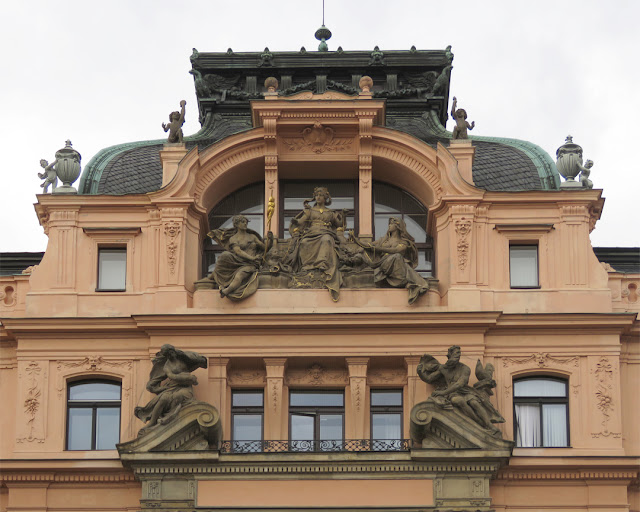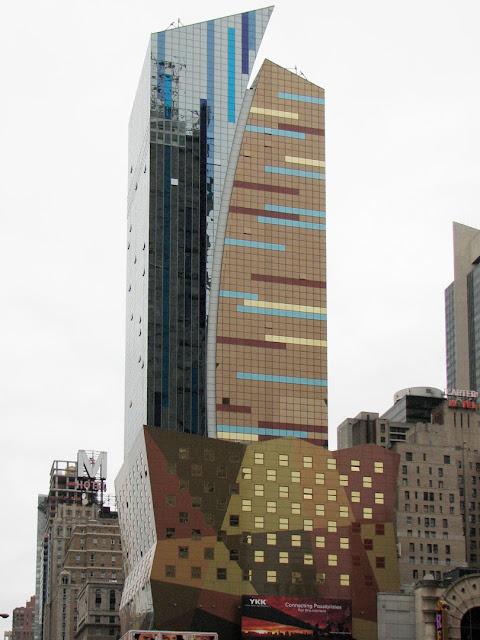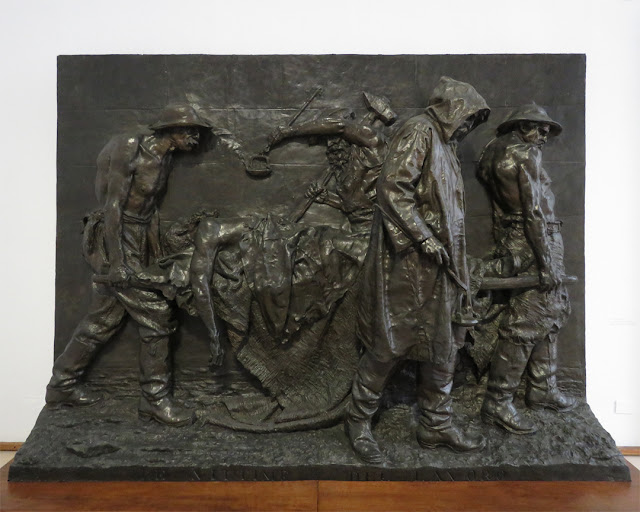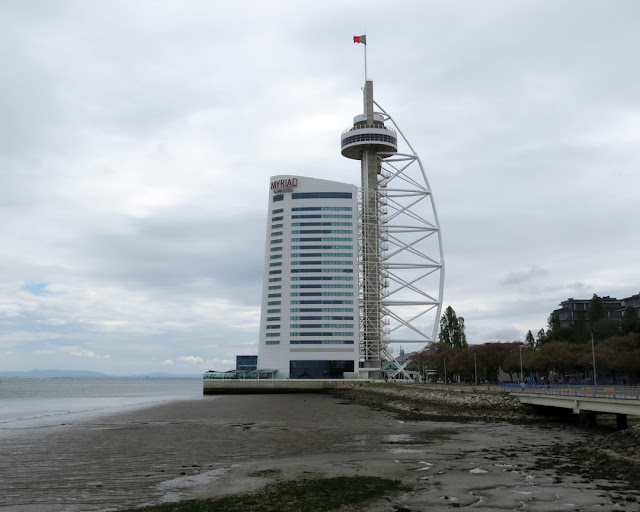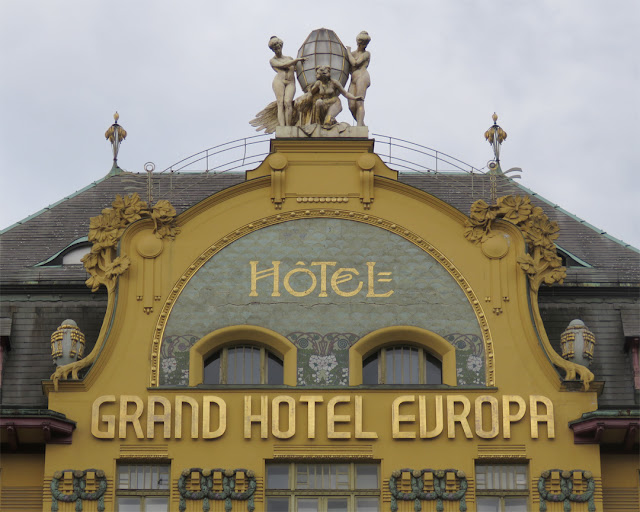Friday, January 31, 2020
Thursday, January 30, 2020
Wednesday, January 29, 2020
Étienne Geoffroy Saint-Hilaire
Grave of Étienne Geoffroy Saint-Hilaire (1772-1844)
Cimetière du Père-Lachaise, (Père Lachaise Cemetery)
Quartier du Père-Lachaise, 20th arrondissement
Paris, July 2014
“Étienne Geoffroy Saint-Hilaire (15 April 1772 – 19 June 1844) was a French naturalist who established the principle of "unity of composition". He was a colleague of Jean-Baptiste Lamarck and expanded and defended Lamarck's evolutionary theories. Geoffroy's scientific views had a transcendental flavor (unlike Lamarck's materialistic views) and were similar to those of German morphologists like Lorenz Oken. He believed in the underlying unity of organismal design, and the possibility of the transmutation of species in time, amassing evidence for his claims through research in comparative anatomy, paleontology, and embryology.” (Étienne Geoffroy Saint-Hilaire, Wikipedia)
Tuesday, January 28, 2020
Time is Out of Joint
“Time is Out of Joint” and Lions by Davide Rivalta, 2017
Galleria Nazionale d'Arte Moderna e Contemporanea
(National Gallery of Modern and Contemporary Art)
Viale delle Belle Arti
Rome, May 2019
“Davide Rivalta’s majestic bronze lions that have been surveying Villa Borghese from the museum steps will no doubt have struck anyone lucky enough to have already visited this gorgeous gallery. Well, this summer this regal pack have become five and accompanying Rivalta’s vast lion drawings in the hallway connecting the North-East and North-West wings. In another reference to Time is Out of Joint, these magnificent beasts are said to act as an acknowledgment to the Museum’s history whilst also being symbolic of art’s unchartered territories.” (Brand-New Exhibits, Romeing)
Monday, January 27, 2020
Sunday, January 26, 2020
Václavské náměstí 19
Václavské náměstí 19 by Friedrich Ohmann and Osvald Polívka
Václavské náměstí (Wenceslas Square)
Nové Město (New City)
Prague, September 2017
“Currently the home of the H&M fashion store in Wenceslas Square, this grand neo-baroque building by Friedrich Ohmann and Osvald Polívka was at one time the headquarters of the Trieste-based insurers Assicurazioni Generali. Between 1 November 1907 and 15 July 1908, Franz Kafka worked for the company in this building, no doubt acquiring that intimate understanding of the machinery of bureaucracy which haunts his writings. The allegorical gable includes statuary by Stanislav Sucharda, Bohuslav Schnirch, Čeněk Vosmík and Antonín Procházka. ” (Václavské náměstí 832/19, Prague Vitruvius)
Saturday, January 25, 2020
Friday, January 24, 2020
Thursday, January 23, 2020
Wednesday, January 22, 2020
Vittime del lavoro
Monumento alle vittime del lavoro by Vincenzo Vela, 1882
Galleria Nazionale d'Arte Moderna e Contemporanea
(National Gallery of Modern and Contemporary Art)
Viale delle Belle Arti
Rome, May 2019
Tuesday, January 21, 2020
Vasco da Gama Tower
Myriad Hotel and Vasco da Gama Tower
Rua Cais das Naus
Parque das Nações
Lisbon, April 2019
“The tower was built in 1998 for the Expo '98 World's Fair. At the base of the tower was a three-story building that served as the European Union Pavilion during the Expo. While they were open, the tower was the tallest structure in Portugal open to the public. The base of the building was to be leased for office space after the closing of the Expo, but never found tenants. Instead, it was used for one-off events, like the world premiere of the new Mini car in 2001. Both the observation deck and the restaurant were closed in October 2004. Parque Expo received permission to expand along the riverside in order construct a 20-floor, 178-room luxury hotel, a plan by Portuguese architect Nuno Leónidas. The base of the tower was demolished between July and September 2007, for the construction of the hotel, which was started in October 2007. The Myriad Hotel was managed by the Portuguese Sana Hotels. The use of the observation deck and the panoramic restaurant resumed via access along the panoramic elevators. The architects of the tower were Leonor Janeiro, Nick Jacobs and SOM and assembled by engineering company Martifer. The architects were inspired by the form of a caravel and its sail, supported by fundamental volumes at its base. This base, enters the river like the bow of the boat, supported by pillars forming a terrace. This area is occupied by exposition spaces and vestibule with access to panoramic elevators that intersperse the tower to the restaurant and viewing platform. The tower is defined by a vertical ‘mast’ and a metallic, tubular ‘sail’, surmounted by a 120-metre platform forming a ‘crow's nest’, corresponding to the rotating restaurant and visitors viewing area.” (Vasco da Gama Tower, Wikipedia)
Monday, January 20, 2020
Sunday, January 19, 2020
Saturday, January 18, 2020
Friday, January 17, 2020
Thursday, January 16, 2020
Triton Fountain
Fontana del Tritone (Triton Fountain) by Gian Lorenzo Bernini, 1643
Piazza Barberini
Rome, May 2019
“Fontana del Tritone (Triton Fountain) is a seventeenth-century fountain in Rome, by the Baroque sculptor Gian Lorenzo Bernini. Commissioned by his patron, Pope Urban VIII, the fountain is located in the Piazza Barberini, near the entrance to the Palazzo Barberini (which now houses the Galleria Nazionale d'Arte Antica) that Bernini helped to design and construct for the Barberini, Urban's family. This fountain should be distinguished from the nearby Fontana dei Tritoni (Fountain of the Tritons) by Carlo Francesco Bizzaccheri in Piazza Bocca della Verità which features two Tritons. The fountain was executed in travertine in 1642–43. At its centre rises a larger than lifesize muscular Triton, a minor sea god of ancient Greco-Roman legend, depicted as a merman kneeling on the sum of four dolphin tailfins. His head is thrown back and his arms raise a conch to his lips; from it a jet of water spurts, formerly rising dramatically higher than it does today. The fountain has a base of four dolphins that entwine the papal tiara with crossed keys and the heraldic Barberini bees in their scaly tails.” (Fontana del Tritone, Wikipedia)
Wednesday, January 15, 2020
Ponte Vasco da Gama
Ponte Vasco da Gama (Vasco da Gama Bridge), 1998
Lisbon, April 2019
“The Vasco da Gama Bridge (Ponte Vasco da Gama) is a cable-stayed bridge flanked by viaducts that spans the Tagus River in Parque das Nações in Lisbon, the capital of Portugal. It is the longest bridge in the European Union, and the second longest in all of Europe after the Crimean Bridge with a total length of 12.3 kilometres (7.6 mi), including 0.8 kilometres (0.50 mi) for the main bridge and 11.5 kilometres (7.1 mi) in viaducts. The bridge is served by 4.8 kilometres (3.0 mi) of dedicated access roads. It was built to alleviate the congestion on Lisbon's 25 de Abril Bridge, and eliminate the need for traffic between the country's northern and southern regions to pass through the capital city. Construction began in February 1995; the bridge was opened to traffic on 29 March 1998, just in time for Expo 98, the World's Fair that celebrated the 500th anniversary of the discovery by Vasco da Gama of the sea route from Europe to India.” (Vasco da Gama Bridge, Wikipedia)
Tuesday, January 14, 2020
Family Kellermann
Grave of family Kellermann
Cimetière du Père-Lachaise, (Père Lachaise Cemetery)
Quartier du Père-Lachaise, 20th arrondissement
Paris, July 2014
Monday, January 13, 2020
Sunday, January 12, 2020
Saturday, January 11, 2020
Grand Hotel Europa
Grand Hotel Europa
Václavské náměstí (Wenceslas Square)
Nové Město (New City)
Prague, September 2017
Friday, January 10, 2020
Palazzo Mattei
The courtyard of the Palazzo Mattei di Giove
Via Caetani
Rome, May 2019
“The Palazzo Mattei di Giove is the most prominent among a group of Mattei houses that forms the insula Mattei in Rome, Italy, a block of buildings of many epochs. To distinguish this section from the others it carries the name of a Mattei fief, Giove. The Mattei owned a number of other palazzi that carried the family name including Palazzo Mattei di Trastevere across the Tiber as well as properties in Umbria, the Palazzo Mattei Paganica. Carlo Maderno designed the palace at the beginning of the 17th century for Asdrubale Mattei, Marquis di Giove and father of Girolamo Mattei and Luigi Mattei. He was also the brother of Ciriaco Mattei and Cardinal Girolamo Mattei. It was Maderno who was responsible for the extravagantly enriched cornice on the otherwise rather plain stuccoed public façade, the piano nobile loggia in the courtyard and the rooftop loggia or altana. For the interior of the palazzo, Pietro da Cortona was commissioned to execute the pair of compositions on the ceiling of the gallery, dating before 1626. In the early 19th century, a group of paintings from the collection at the palazzo was purchased by William Hamilton Nisbet and removed to Scotland. Like others of the Mattei family, Asdrubale Mattei was an enthusiastic patron of the arts. Michelangelo Merisi da Caravaggio (better known simply as Caravaggio) is recorded as living at the palazzo in 1601.” (Palazzo Mattei, Wikipedia)
Thursday, January 9, 2020
Centro Vasco da Gama
Centro Vasco da Gama
Avenida Dom João II
Lisbon, April 2019
“Strategically located in a prime area of Lisbon – the Parque das Nações – the Vasco da Gama Shopping Centre gears its offering towards a wide target public that includes not only tourists but also people who live and work in the surrounding area and the cities of Lisbon and Loures. The centre opened its doors to the public in 2009 and since then has become a benchmark for everyone who values the option of combining shopping with leisure and free-time activities. To accommodate its many visitors, the Vasco da Gama Centre has around 2,600 parking spaces and 170 shops covering a total gross area of around 49,000m2. Apart from the huge selection of shops, the centre also features a six-screen cinema and a health club.” (Centro Vasco da Gama, VisitLisboa)
Wednesday, January 8, 2020
Tuesday, January 7, 2020
San Martino del Vescovo
Frescoes
San Martino del Vescovo
Piazza di San Martino
Florence, December 2018
“Nine of the interior frescoes are attributed to the workshop of Domenico Ghirlandaio although their dating remains a contentious issue. Eight of the cycle of ten murals are based on the Seven Works of Corporal Mercy and show the Buonomini performing activities based on these tasks. The brothers are depicted giving food and drink to the thirsty, clothing the naked, visiting the sick, giving shelter to pilgrims, releasing a debtor from gaol, burying the dead, witnessing an espousal and making an initial visit to a family in need. The two frescoes which flank the altar show scenes from the life of St Martin of Tours. The lunette to the left of the altar shows Martin dividing his cloak for the beggar and the one to the right, depicts The Dream of Saint Martin; the latter has recently been attributed to Lorenzo di Credi. Inside is an altarpiece of a Madonna with Infant Jesus and St. John by Niccolò Soggi and a bust of St Antoninus which is attributed to Verrocchio.” (San Martino del Vescovo, Wikipedia)
Monday, January 6, 2020
Sunday, January 5, 2020
Foliage
Foliage work detail of the dome
Secessionsgebäude (Secession Building)
Friedrichstraße
Vienna, September 2017
“The Secession Building (German: Secessionsgebäude) is an exhibition hall in Vienna, Austria. It was completed in 1898 by Joseph Maria Olbrich as an architectural manifesto for the Vienna Secession,[1] a group of rebel artists that seceded from the long-established fine art institution.” (Secession Building, Wikipedia)
Saturday, January 4, 2020
Lupa Capitolina
Copy of the “Lupa Capitolina” (Capitoline Wolf)
Piazza del Campidoglio
Capitoline Hill
Rome, May 2019
“The sculpture is somewhat larger than life-size, standing 75 cm (30 in) high and 114 cm (45 in) long. The wolf is depicted in a tense, watchful pose, with alert ears and glaring eyes, which are watching for danger. By contrast, the human twins – executed in a completely different style – are oblivious to their surroundings, absorbed by their suckling.” (Capitoline Wolf, Wikipedia)
Friday, January 3, 2020
Gare do Oriente
Gare do Oriente
Avenida Dom João II
Lisbon, April 2019
“he station was inaugurated on 19 May 1998, as part of the celebrations marking the opening of the Expo '98 world's fair. At the time of its opening it was considered the largest intermodal station in Portugal, winning the Brunel Award on 7 October 1998, in the category of large new construction projects. Oriente Station is situated in an urban area of reclaimed industrial and abandoned buildings fronting the northern margin of the Tagus River, situated 6 kilometres (3.7 mi) from the city centre. Ambitious in its conception, the modernist station includes a Lisbon Metro station, a high-speed commuter and regional train hub, a local, national and international bus station, a shopping centre and a police station. The rail station was conceived with a multi-modal platform intersecting the cardinal axes for the various transport modes.” (Gare do Oriente, Wikipedia)
Thursday, January 2, 2020
Wednesday, January 1, 2020
Florence Cathedral Lantern
Lantern of the Dome
Santa Maria del Fiore (Saint Mary of the Flower)
Piazza del Duomo
Florence, December 2018
“In 1418, the competition for the construction of the Florence Cathedral Lantern was held, and Brunelleschi emerged victorious. However, the directors had but one more stipulation that Lorenzo Ghiberti should collaborate with him as an overseer for the work. Distraught and frustrated, Brunelleschi was so irritated that he nearly wrecked his model. It was his friends Luca Della Robbia and Donatello that in place advised him to fake he was ill and turn in all responsibility and obligations to Ghiberti. Having followed their guidance, it wasn't too long until Ghiberti came to a cessation and disclosed that he was unable to grasp the full workings and implementation of the project. Having emerged victorious over his rival, Brunelleschi commenced the erection of the lantern in 1420 and immersed the rest of his lifetime working on the project, even though he did still oversee the construction of other monuments that were vital to the legacy of Renaissance Florence. The last tribute that he erected consisted of a 91 metres high double cupola of brick, wholly self-supporting and grounded on a profound system of flying instead of using fixed centre rings. The peripheral of the cupola spotted stone ribs and domical vaults, but all together reproducing the same pointy arch profile desired to utter precision. In 1434, the Prodigious Cupola or the ‘Cupolone’, as the locals often christened it ever since erection, was finalized. Two years down the line, the lantern was in turn locked in position, taking the momentous construction from 91 to 114.5 Metres. While in 1438, the tribunes occupying recesses formed in the construction of the octagon lantern apse were built. The adornments in the lantern, on the other hand, were concluded by 1446, when Brunelleschi was on his deathbed. In 1461, finishing touches to the lantern’s decorations were done, with the placing of the remarkable copper sphere being done by 1474. Cast in Verrocchio’s workshop and pulleyed up through a machine constructed with aid of Leonardo da Vinci. However, on July 17th 1600, the bell fell on the account of being hit by lightning and was interchanged two years down the line with an even bigger one. A marble plaque honouring this occurrence is still discernable on the paving behind the cathedral.” (Florence Cathedral Lantern, www.filippo-brunelleschi.com)
Subscribe to:
Posts (Atom)






